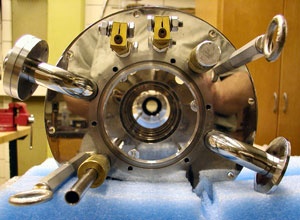Apr 29 2009
Physicists at the U.S. Department of Energy's Ames Laboratory have experimentally demonstrated that the superconductivity mechanism in the recently-discovered iron-arsenide superconductors is unique compared to all other known classes of superconductors. These findings - combined with iron-arsenide's potential good ability to carry current due to their low anisotropy - may open a door to exciting possible applications in zero-resistance power transmission.
 A unique tunnel diode resonator was used to measure London penetration depths of iron-arsenide crystals. A tunnel diode resonator precisely measures magnetic responses at very low temperatures, and Ames Laboratory is one of the few research facilities in the world with TDR instrumentation.
A unique tunnel diode resonator was used to measure London penetration depths of iron-arsenide crystals. A tunnel diode resonator precisely measures magnetic responses at very low temperatures, and Ames Laboratory is one of the few research facilities in the world with TDR instrumentation.
The research, led by Ames Laboratory physicist Ruslan Prozorov, has shown that electron pairing in iron-arsenides is likely to be very different when compared to other types of known superconductors. In superconducting materials, electrons form pairs, called Cooper pairs, below a critical temperature and these electron pairs behave identically. The collective flow of Cooper pairs results in the most famous feature of a superconductor and the feature that draws the most interest in terms of energy efficiency: the flow of electrical current without any measurable loss of energy, or true zero resistance.
However, superconductors also have another inherent characteristic that distinguishes them from a perfect metal. Unlike perfect metals, superconductors expel a weak magnetic field from their interiors no matter whether they are cooled in a magnetic field or whether the magnetic field is applied after cooling. In either case, a weak magnetic field penetrates only a narrow region at a superconductor's surface. The depth of this region is known as the London penetration depth.
“The change of the London penetration depth with temperature is directly related to the structure of the so-called superconducting gap, which in turn depends on the microscopic mechanism of how electron pairs are formed,” said Prozorov. “London penetration depth is one of the primary experimentally measurable quantities in superconductor studies.”
The variation of the London penetration depth with temperature depends on the superconducting gap structure and is already generally agreed upon in most other known classes of superconductors. In conventional superconductors - the class made up of periodic table elements, including lead and niobium - this dependence is exponential at low temperatures. In the high-temperature cuprate superconductors, the relationship is linear, and in magnesium-diboride superconductors the dependence is exponential, but requires two distinct superconducting gaps to explain the data in a full temperature range.
In contrast, the Ames Laboratory research group, which includes physicists Ruslan Prozorov and Makariy Tanatar, postdoctoral researcher Catalin Martin, and graduate students, Ryan Gordon, Matt Vannette and Hyunsoo Kim, found that iron-arsenide superconductors exhibit a power-law - almost quadratic - temperature variation of penetration depth. The team's results were published in the March 27 issue of Physical Review Letters and the March 24 issue of Physical Review B: Rapid Communications.
The iron-arsenide superconductors' unique power-law variation of London penetration depth was observed across several FeAs-based systems. The Ames Lab group studied large single crystals of barium-iron-arsenic in which cobalt was substituted for part of the iron, grown and characterized at Ames Lab by senior physicist Paul Canfield's research group. They also studied neodymium-iron-arsenic-oxide and lanthanum-iron-arsenic-oxide samples grown and characterized by Canfield's group.
“We are very lucky to be able to collaborate with Paul Canfield, Sergey Bud'ko and their students. When studying novel materials, one needs to examine dozens of different samples and compositions to arrive at some general conclusions. Canfield and Bud'ko are among the best in their field, and our very fruitful collaboration is based on mutual interests, intellectual, and geographical proximity— even our lab spaces neighbor each other's, and we are very happy about it.” said Prozorov.
A unique tunnel diode resonator technique was used to measure the London penetration depths of the iron-arsenic crystals. A tunnel diode resonator precisely measures magnetic responses at very low temperatures, and Ames Laboratory is one of the few research facilities in the world with TDR instrumentation.
“This type of research requires measurements of many, nominally the same, samples in three different orientations with respect to an applied magnetic field,” said Prozorov. “All along, we expected to see an exponential London penetration depth - but we didn't. So, we examined samples with different concentrations of cobalt. But we got the same results, and with data from other iron-arsenide systems, we observed a universal, nearly quadratic behavior of the penetration depth.”
Since London penetration depth is tied to electron-pairing behavior, the Ames Lab group's findings suggest that the iron-arsenides also exhibit electron pairing different from any other known superconductor. In addition, the group found unambiguous evidence that the iron-arsenide superconductors' full data set can only be explained with two distinct superconducting gaps. Thus, the iron-arsenic superconductors appear to exhibit properties of both high-temperatures cuprates and magnesium diboride.
“The iron-arsenides are probably among most complex superconductors we - the superconductor research community - have encountered so far,” said Prozorov. “Altogether, analysis of the data collected on many samples shows that the iron-arsenides do not adhere to the previous superconductivity theories and that something else is happening. Of course, some theoretical models do exist, and we collaborate with leading theorists, including Ames Laboratory's Jörg Schmalian, who has provided important insight into our observations. The unique qualities of the iron-arsenides cause me to believe that materials where transition temperature is closer to room temperature are possible. ”
The Ames Laboratory research on iron-arsenide superconductors' London penetration depth was conducted by the Complex States, Emergent Phenomena, and Superconductivity in Intermetallic and Metal-like Compounds Field Work Proposal group, led by physicist Paul Canfield. The research is funded by the U.S. Department of Energy's Office of Science.